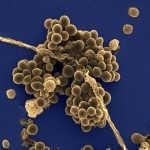Link to Pubmed [PMID] – 3053566
J. Antimicrob. Chemother. 1988 Jul;22 Suppl B:13-23
Macrolide antibiotics constitute a group of 12 to 16-membered lactone rings substituted with one or more sugar residues, some of which may be amino sugars. They inhibit bacterial protein synthesis both in vivo and in vitro with varying potencies. Macrolides are generally bacteriostatic, although some of these drugs may be bactericidal at very high concentrations. The mechanism of action of macrolides has been a matter of controversy for some time. Spiramycin, a 16-membered macrolide, inhibits translocation by binding to bacterial 50S ribosomal subunits with an apparent 1:1 stoichiometry. This antibiotic is a potent inhibitor of the binding to the ribosome of both donor and acceptor substrates. Spiramycin induces rapid breakdown of polyribosomes, an effect which has formerly been interpreted as occurring by normal ribosomal run-off followed by an antibiotic-induced block at or shortly after initiation of a new peptide. However, there is now convincing evidence that spiramycin, and probably all macrolides, act primarily by stimulating the dissociation of peptidyl-tRNA from ribosomes during translocation. Although the ribosomes of both Gram-positive and Gram-negative organisms are susceptible to macrolides, these antibiotics are mainly used against Gram-positive bacteria since they are unable to enter the porins of Gram-negative bacteria. Resistance to macrolides in clinical isolates is most frequently due to post-transcriptional methylation of an adenine residue of 23S ribosomal RNA, which leads to co-resistance to macrolides, lincosamides and streptogramins type B (the so-called MLSB phenotype). Other mechanisms of resistance involving cell impermeability or drug inactivation have been detected in Staphylococcus spp. and Escherichia coli. These strains are resistant to 14-membered macrolides (erythromycin and oleandomycin) but remain susceptible to spiramycin.

